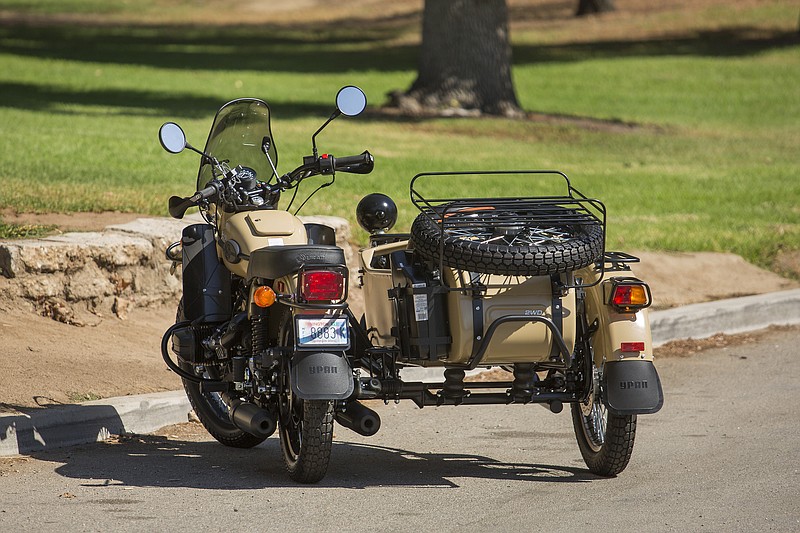The Russian-made Ural Sahara looks like a beautifully preserved sidecar motorcycle, a barn find pulled from some remote Siberian grain silo.
But it's actually brand new, and it's made this way on purpose. Rude, rugged and retro, it may be the fastest way on wheels to get attention and make new friends.
The Ural motorcycle company got its start copying BMW R71 motorcycles for military use in the 1940s, after Josef Stalin decided he wanted battlefield bikes just like the Germans had.
His minions reportedly bought four, through a secret Swedish intermediary, and had them shipped to Moscow. They were dismantled and reverse engineered, and a year later, the first copies were seeing duty on the Western Front.
More than 75 years later, Ural is still building the basic machine the same way.
All the motorcycles in the Ural line are powered by an air-cooled, 750 cubic centimeters "boxer" twin four-stroke engine that makes 41 horsepower and 42 pound feet of torque, through a six-speed transmission and shaft drive.
They look like vintage bikes, sound like vintage bikes and ride the same way. They're clunky, clumsy, stodgy and slow-and so much fun!
Since I rode and reviewed my first Ural Gear Up, a few years back, the company (whose machines are imported by an outfit in Redmond, Wash.) has made useful updates. The Urals now feature Brembo disc brakes on the front and sidecar wheels and fuel injection.
The Urals are burly, weighing in at 730 pounds, with no fuel in the gas tank and without a passenger in the rumble seat. And, like all sidecars, they require a certain amount of muscle, and patience, to operate.
Riding one in a straight line, on a flat road, is easy work. (Although stopping one, without available ABS, is a little challenging.) Riding one on any other surface, or with any kind of twists or turns, is a more athletic affair.
On one sharp right-hand turn, I felt the sidecar's side wheel leave the pavement and float a bit. This is what sidecar stallions call "flying the wheel." It doesn't happen when the sidecar is carrying a load. That's why some sidehacks keep a cinder block or sack of sand in the sidecar when they're riding solo.
The suspension, from retro leading link front end to the old-fashioned-feeling twin Sachs hydraulic shocks, is stiff. It's ready to support a fully loaded luggage rack or a sidecar full of best friend, but when unladen, it's pretty hard on the potholes. The rear is adjustable, but the front is not.
The Urals feature modern electric starters but also have a good, old-fashioned kick-starter. Just for fun, and to make fun of how hard these beasts are to operate, I tried kick-starting the bike to life, wearing sneakers. Impressively, the Sahara started right up.
Because of its weight and three-wheeled construction, the Ural features a hand-activated parking brake and a reverse gear, activated by a right-side pedal.
There's also a hand lever that will engage the Ural's unusual two-wheel drive. This connects straight-cut gears in the wheel hub through a drive shaft to the outside sidecar wheel.
Thus weaponized, the Ural can climb out of deep sand, soft snow or whatever tar pit it's fallen into. But it can't be steered in this high-traction formulation. It'll pull you out of the muck, but only in a more or less straight line.
Ural makes several machines for export into the U.S. The sand-colored Gear Up Sahara version, new this year, is ready for desert duty.
It comes standard with a locking storage compartment big enough for two full-face helmets, spare tire, tire pump, a small locking compartment built into the top of the gas tank, a full tool kit, canvas sidecar cover, sidecar-mounted spotlight, plug-ins for accessories, a metal jerry can and a utility shovel.
(The jerry can has a label on it reading, "Not for gasoline and drinking water." So, that's where you keep the Stoli.)
Said to get about 35 miles to the gallon, the Ural has a range of up to 180 miles to its five-gallon tank. And 180 miles would be quite a lot of riding on this beast, which will go long and hard, but not fast. Although it has an advertised maximum cruising freeway speed of 70 mph, this rider didn't feel confident going more than 60.
The Sahara also can be had with a very robust "Off Road Package," which includes fog lights, aftermarket windscreen, extra luggage racks, engine and body guards, and an Enduro-style bench seat.
It adds up to an extremely handsome, eye-grabbing package that, around town, gets a remarkable amount of attention. Like, a lot.
Having driven in any number of extremely exotic and expensive two- and four-wheeled vehicles, I can say I never got noticed more than the two times I rode around on Urals.
The entry-level Sahara retails for $17,999, before tax, license and handling. The "Off Road Package" adds $1,999, and an upgraded exhaust goes for an additional $1,499. Heidenau K37 knobby tires are also available, at $550 a set.
That adds up to a chunky hunk of change. And while three-wheeled Harley-Davidsons, after-market sidecar Honda Gold Wings or triangulated Can-Am Spyders are equally expensive, they're all mechanically superior to the Ural-more comfortable to ride, easier to get parts for, better made and likelier to last longer.
But if you want to make friends fast and feel like a celebrity at every stoplight, the Ural is for you.

